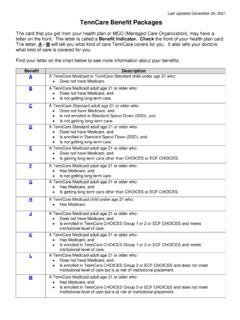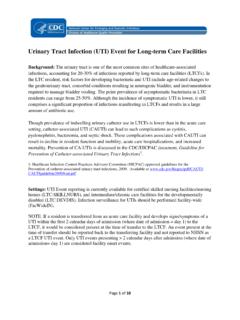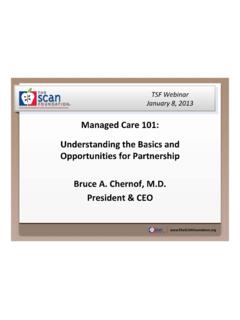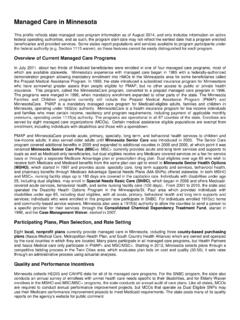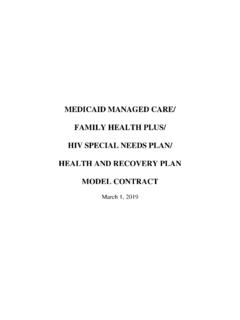Transcription of Managed Care 101: Utilization Management
1 Slide 1 Managed care 101: Utilization ManagementMelanie Lite MatthewsCEO, Physicians of Southwest WashingtonCAPG SymposiumOctober 27, 2016 Slide 2 Slide 2 Content Overview Background to importance of coordinated care Building the care is the future: Think Outcome Data supports Utilization Management What is Utilization Management ? Essentials of Utilization Management Population Health Advanced care Management Importance of Comprehensive Primary care and Primary care Medical Home Models? Payor Contracts and UM Silos of Concern and Importance: Pharmacy and Behavioral HealthSlide 3 Slide 3 MACRA: Demise of FFS and Volume Based Reimbursement for Medicare BeneficiariesMIPS and APM models all promote quality and cost MIPS criteria applied to 2017 services 0% based on cost of care 60% based on quality of care 15% based on clinical care improvement activities 25% based on advancing care information (formerly meaningful use )Impact.
2 +/-4% adjustment to 2019 FFS, with winners and losers Alternative Payment Models Must be participant in designated APM model including accountability for quality and costImpact: 5% increase to 2019 FFS reimbursement all winners!Commercial and Other Payors Historically Follow Medicare Slide 4 Cost of care Remains a Problem Slide 5 AtlasCoverage5A Study to see regional variation, and to compare the performance of integrated care vs. fragmentedcareSlide 6 Slide 6 All across CA, HMO OutperformsPPO in 5out of 6 clinicalquality measures7 Slide 7 HMOs:HigherQualityLowerCostPPOs:LowerQua lityHigherCost9 Slide 8 Slide 8 Bottom Line: Health care Reform is Here Many physicians and physician groups are not aware of MACRA and how it will impact their Medicare reimbursement, first for Medicare and likely other payors to follow.
3 Physicians and other providers need to align with others, including institutions and select payors, and collaborate in very different ways. Integrated medical groups on a common EMR have head start in data sharing; IPA structures can provide infrastructure for those not employed by an integrated health system or insurer. Timely and accurate clinical and cost data is essential to improving quality lowering costs. Building and sustaining this data infrastructure is complex and very expensive. Interoperability of electronic medical data is goal but far from current reality.
4 Some payors reluctant to share detailed cost provider agreements with payors demand data and may or may not delegate UM functions to the medical group or IPA. If capacity to accept delegation is not yet present, or key payor refuses to delegate, agreements need to hold payor accountable for timely sharing of UM data with clinical providers. Slide 9 AtlasMeasures6 IHA Atlas Measures Slide 10 Slide 10 Utilization Management : DefinitionURAC Utilization Management (UM) is the evaluation of the medical necessity, appropriateness, and efficiency of the use of health care services, procedures, and facilities under the provisions of the applicable health benefits plan, sometimes called Utilization review.
5 IOM s Committee on Utilization Management by Third Parties (1989)A set of techniques used by or on behalf of purchasers of health care benefits to manage health care costs by influencing patient care decision-making through case-by-case assessments of the appropriateness of care prior to its 11 Slide 11 More current and explicit descriptions of Utilization Management (UM)Wikipedia Definition: ..the evaluation of the appropriateness and medical need of health care services and procedures and facilities according to evidence-based criteria or guidelines, and under the provisions of an applicable health benefits plan.
6 Typically, UM addresses new clinical activities or inpatient admissions based on the analysis of a case, but may relate to ongoing provision of care , especially in an inpatient setting. URAC standards are intended to ensure that the UM process .. is clinically sound and respects patients and providers rights while giving payers reasonable guidelines to follow. URAC s standards address the use of evidence-based guidelines, outline specific reviewer requirements for each level of review, and require a policy preventing financial incentives to doctors and other providers based on consumers use of health Slide 12 Slide 12 NCQA Utilization Management Standards and GuidelinesUtilization Management ComponentStandards and GuidelinesInternal Quality Improvement Process Clinical Information Agreement and Collaboration with Clients.
7 DelegationDenial NoticesPrivacy and ConfidentialityPolicies for AppealsUM Program StructuresAppropriate Handling of AppealsClinical Criteria for UM DecisionsSatisfaction with the UM ProcessCommunication Services (access to staff)Emergency ServicesAppropriate ProfessionalsTriage and Referral for Behavioral HealthcareTimeliness of UM DecisionsDelegation of UM ActivitiesSlide 13 Slide 13 Other Standards for UM Procedures CMS Managed care Manual State Insurance Regulatory Bodies Individual Health Plans and Payor Requirements Specialty Medical Society GuidelinesImpact for Medical Groups Involved in UM: Standards may vary among payors and between plans and the UM process must be flexible to handle differing requirements.
8 Conflicts can arise particularly between CMS and State Regulatory bodies with regard to MA plans, with CMS regulating plans with the exception of licensure and financial solvency matters. Specialty societies may also disagree on preferred preventative screenings and their frequency, and on treatment recommendations. Different timeliness standards may apply between payor contracts, often referred to as TATs. Different documentation and communication tools may be required among payors. Interpretations of whether standards are being implemented correctly can vary among auditors for plans and CMS at delegation audits, particularly focused on necessary provider and patient communications in the event of a 14 Slide 14 Potential Issues with Criteria Payors may use different criteria and may require their data set be applied for their population.
9 If provider group uses different criteria than payor, sharing data for time critical responses to appeals and grievances can be problematic. Plans rarely delegate appeals and grievances. Criteria are updated at different frequencies and local adaptation may be appropriate for clinically evolving therapies. Example: joint replacement may be approvable only after PT trial, even when bone-on-bone X-rays may demonstrate lack of efficacy for PT. Local criteria need to be reviewed and confirmed by competent medical committee Criteria may be ambiguous or subject to significant clinical interpretationExample.
10 Determination as to whether criteria for inpatient vs observation admission have been met related to severity of illness and intensity of service, or when criteria for safe discharge have been metSlide 15 Slide 15 Sources for UM Criteria Alone or In-Combination Develop In-house (may be challenged on content, must be continually refreshed, and need to be integrated into data base in event decision is appealed by a patient, provider, or payor) Acquire from vendor (sometimes payor or medical group may not have sufficient expertise for specialized services, often pharmacy and behavioral health) Acquired and adapted for local conditionsCommonly used frameworks.
